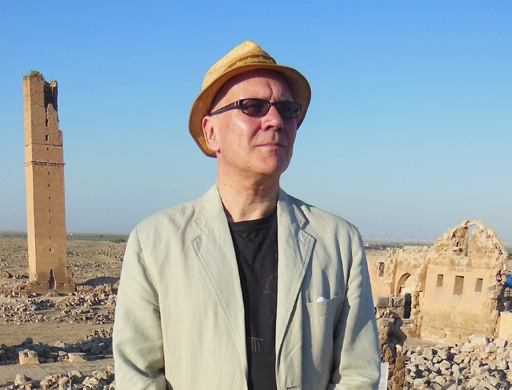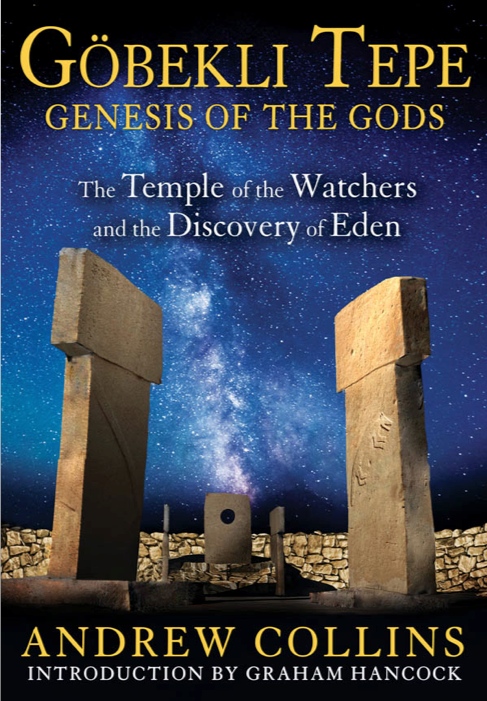
Göbekli
Tepe: Genesis of the Gods:
The
Temple of the Watchers and the Discovery of Eden
A
STUNNING NEW BOOK BY
Andrew Collins
WITH
AN INTRODUCTION FROM
GRAHAM HANCOCK
Göbekli Tepe in southeast Turkey (Pic: Andrew Collins)
Göbekli
Tepe is a name familiar
to anyone interested in the ancient mysteries subject. Billed as the oldest stone
temple in the world, it is composed of a series of megalithic structures containing
rings of beautifully carved T-shaped pillars. It sits on a mountain ridge in southeast
Turkey, just 8 miles (13 kilometers) from the ancient city of Urfa, close to the
traditional site of the Garden of Eden. Here, for the past ten thousand years,
its secrets have remained hidden beneath an artificial, belly-shaped mound of
earth some 330 by 220 yards (300 m by 200 meters) in size. Agriculture and animal
husbandry were barely known when Göbekli Tepe was built, and roaming the
fertile landscape of southwest Asia were, we are told, primitive hunter-gatherers,
whose sole existence revolved around survival on a day-to-day basis.
So
what is Göbekli Tepe? Who created it, and why? More pressingly, why did its
builders bury their creation at the end of its useful life?
These
are the questions I ask in new book Göbekli Tepe: Genesis of the Gods, in
which I provide compelling evidence that the myths of the Watchers of the book
of Enoch and the Anunnaki of Mesopotamian myth and legend are memories of the
Göbekli builders and their impact on the rise of civilization. I believe
also that Göbekli Tepe was constructed by a hunter-gatherer population still
in fear following a devastating cataclysm that nearly destroyed the world - a
comet impact that science today recognizes as having taken place around 12,900
years ago, with terrifying after shocks that lasted for several hundred years
afterward.
Human Hybrids
Yet
it seems unlikely that those who came up with a plan to counter the innate fear
of another cataclysm (something that visionary and writer Barbara Hand Clow so
aptly calls catastrophobia) were the indigenous population. This appears to have
been orchestrated by members of an incoming culture, composed of groups of shamans,
warriors, hunters and stone tool specialists of immense power and charisma. Their
territories, across which they traded different forms of flint, as well as hematite
used as red ochre, stretched from the Carpathians Mountains in the west to the
Russian steppes and plain in the east. More incredibly, anatomical evidence points
to them being of striking appearance - tall, with extremely long heads, high cheekbones,
long faces, large jaws, and strong brow ridges, which some have seen as evidence
they were Neanderthal-human hybrids. So who were these people?

Did
the comet impact of 10,900 BC lead to the construction of Göbekli Tepe?
|
Rise
of the Swiderians
The
answer is the Swiderians, whose mining operations in Poland's Swietokrzyskie (Holy
Cross) Mountains are among the earliest evidence of organised mining activities
anywhere in the world. This advanced society, who thrived in both Central and
Eastern Europe around the time of the comet impact event of 10,900 BC, was responsible
for the foundation of various important post-Swiderian cultures of the Mesolithic
age as far north as Norway, Finland, and Sweden, as far south as the Caucasus
Mountains, and as far east as the Upper Volga river of Central Russia. The Swiderians'
highly advanced culture, which included a sophisticated stone tool technology,
was derived from their distant ancestors, the Eastern Gravettian peoples that
thrived between 30,000 and 19,000 BC in what is today the Czech Republic and further
east on the Russian Plain.
In around 10,500 BC I believe that Swiderian groups
moved south from the East European Plain into eastern Anatolia. Here they gained
control of the regional trade in the black volcanic glass known as obsidian at
places like Bingöl Mountain in the Armenian Highlands and Nemrut Dag, an
extinct volcano close to the shores of Lake Van, Turkey's largest inland sea.
This brought them into contact with the communities who would later be responsible
for the construction of Göbekli Tepe around 9500-9000 BC.
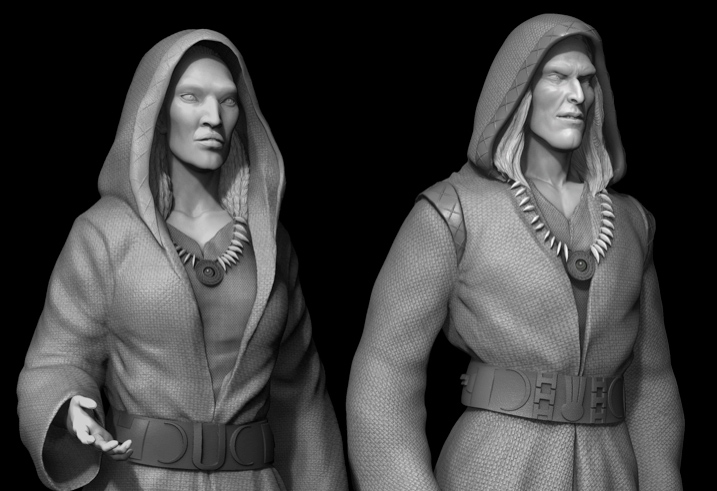
3D
digital sculpt by artist Russell M. Hossain of Swiderians, who included among
their society Neanderthal-human hybrids of striking appearance. Is this the face
of the Göbekli builders, as well as the Anunnaki of Mesopotamian mythology
and the Watchers of the book of Enoch? (Pic: Russell M. Hossain) |
Ritual
Purpose
Everything suggests the Swiderians possessed a sophisticated cosmology gained in part from their cousins, the Solutreans of Central and Western Europe, who were themselves related to the Eastern Gravettian peoples. They believed in a cosmic tree supporting the sky world entered via the Great Rift-the fork or split in the Milky Way caused by the presence of stellar dust and debris-corresponding to the position in the northern heavens occupied by the stars of Cygnus, the celestial swan (a.k.a. the Northern Cross). The Swiderians believed also that birds were symbols of astral flight, and that this was the manner in which the shaman could reach the sky world. In Europe the bird most commonly associated with these beliefs and practices was the swan, while in Southwest Asia it was the vulture, a primary symbol of death and transformation in the early Neolithic age. Both birds are identified with the Cygnus constellation.
Using
this guise the shaman could enter the sky world and counter the actions of the
supernatural creature seen as responsible for cataclysms like the comet impact
of 10,900 BC, referred to by scientists today as the Younger Dryas Boundary (YDB)
event. This cosmic trickster was seen to take the form of a sky fox or sky wolf,
embodied perhaps in the leaping foxes carved in relief on the inner faces of key
pillars at Göbekli Tepe, and remembered also as the Fenris-wolf responsible
for causing Ragnorak, a major cataclysm preserved in Norse mythology. All across
Europe, and into Southwest Asia, accounts exist of supernatural foxes and wolves
that have attempted to endanger the sky pillar supporting the starry canopy, an
act that if achieved would have brought about the destruction of the world.
Someone realized that only by allaying people's fears regarding the immense potency of the cosmic trickster could stability be truly restored to the world. And whenever this supernatural creature returned to the heavens in the guise of a comet-seen as a visible manifestation of the sky fox or sky wolf-it would be the shaman's role to enter the sky world and counter its baleful influence, a primary motivation I see as behind the construction of Göbekli Tepe.
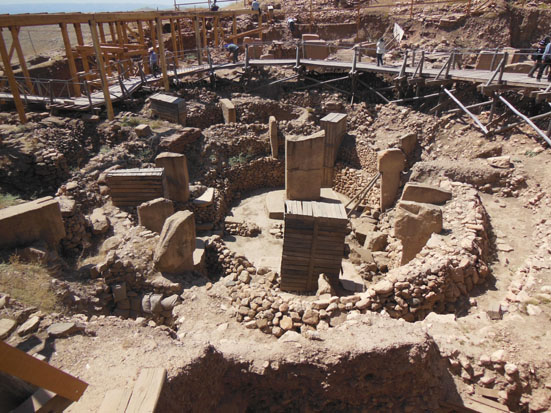
Göbekli
Tepe's Enclosure C.
Womb
Chambers
Yet
there were clearly other reasons for the construction of Göbekli Tepe. Its
stone enclosures served, most likely, as womb chambers, places where the shaman
entered into a primal state, like that experienced before birth, after passing
between the enclosures' twin central pillars. These enormous monoliths, sometimes
18 feet (5.5 meters) in height and weighing as much as 16.5 US tons (15 metric
tonnes) a piece, acted as otherworldly portals to invisible realms - true stargates
in every sense of the word. And their target: the setting down on the local horizon
of Deneb, Cygnus's brightest star, which marked the start of the Milky Way's Great
Rift, a role played by Deneb as early as 16,500-14,000 BC. At this time Deneb
acted as Pole Star, the star closest to the celestial pole during any particular
epoch. Even after Deneb ceased to be Pole Star around 14,000 BC, due to the effects
of precession (the slow wobble of the earth's axis across a cycle of approximately
26,000 years), its place was taken by another Cygnus star, Delta Cygni, which
held the position until around 13,000 BC.
After
this time the role of Pole Star went to Vega in the constellation of Lyra, the
celestial lyre. When around 11,000 BC Vega moved out of range of the celestial
pole, no bright star replaced it for several thousand years. This meant that when
Göbekli Tepe was constructed, ca. 9500-9000 BC, there was no Pole Star. It
was for this reason that Deneb, and the Milky Way's Great Rift, retained their
significance as the main point of entry to the sky world, making it the primary
destination of the shaman. Standing stones erected in the north-northwestern sections
of the walls in two key enclosures at Göbekli Tepe bore large holes that
framed the setting of Deneb each night, highlighting the star's significance to
the Göbekli builders, and showing the precise direction in which the shaman
should access the sky world.
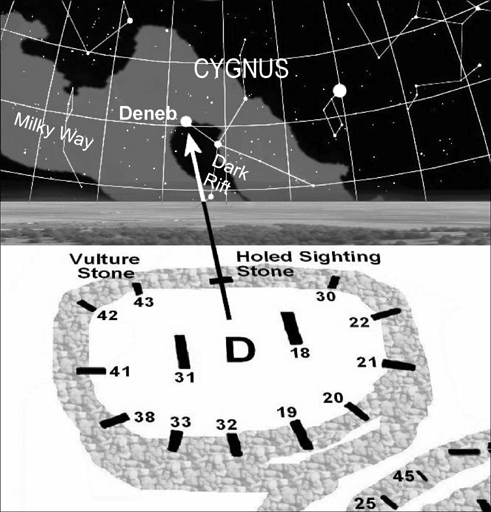 | Göbekli Tepe's Enclosure D, showing its alignment through the holed stone towards the Milky Way's Great Rift and the bright star Deneb in Cygnus, the celestial swan (Pic: Rodney Hale). |
Cosmic
Knowledge
Everywhere
you look at Göbekli Tepe there is confirmation that its builders shared a
sense of connection with the cosmos. From the strange glyphs and ideograms on
the various stones, which include symbols resembling the letters C and H, to the
twelvefold division of stones in the various enclosures, there is powerful evidence
that these 11,000-year-old temples resonate the influence of the celestial heavens.
The H glyphs seem to relate to the shaman's journey from this world to the otherworld,
while the C glyphs are almost certainly slim lunar crescents signifying the transition
from one lunar cycle to the next. Even the design of the enclosures appears to
have cosmic significance. Invariably the structures are ovoid in shape, with a
length to breadth ratio of 5:4, numbers that could hint at the Göbekli builders'
profound awareness of cosmic time cycles not usually thought to have been understood
until the age of Plato.
If Swiderian groups were the shamanic elite responsible for Göbekli Tepe, then there is every chance that the cosmic knowledge encoded into its construction came, at least in part, from highly evolved individuals who were by nature Neanderthal-human hybrids of striking physical appearance. These people were most likely the product of interactions between Neanderthals and Anatomically Modern Humans at the dawn of the Upper Paleolithic age, c. 40,000-30,000 BC. This is a very exciting realization that tells us that we might well have underestimated the dynamic potency of hybridization in the formative years of human history.

Leaping
fox on the inner face of Enclosure B's western central pillar. Do this show the
cosmic trickster in the form of a sky fox? |
Final
Abandonment
Over
a period of around 1,500 years twenty or more major enclosures were constructed
within the gradually emerging occupational mound at Göbekli Tepe. Old enclosures
were periodically decommissioned, deconsecrated and covered over, quite literally
"killed," at the end of their useful lives. New structures were built
to replace them, but as time went on they became much smaller in construction,
until eventually the cell-like buildings were no larger than a family-sized Jacuzzi
with pillars no more than five feet (a meter and a half) in height. Somehow the
world had changed, and the impetus for creating gigantic stone temples with enormous
twin monoliths at their centers was no longer there.
Sometime around 8000 BC
the last remaining enclosures were covered over with imported earth, stone chippings
and refuse matter, and the site abandoned to the elements. All that remained was
an enormous belly-like mound that became an ideal expression of the fact that
the stone enclosures had originally been seen, not just as star portals to another
world, but also as womb-like chambers, where the souls of shaman, or indeed the
spirits of the dead, could quite literally journey to the source of creation,
located somewhere in the vicinity of the Cygnus constellation. It was a concept
dimly remembered in the name Göbekli Tepe, which in Turkish means "navel-like
hill."
Serpent-headed
People
Even
after Göbekli Tepe was abandoned, its memory, and those of the ruling elite
behind its construction, lingered on among the Halaf and Ubaid peoples who flourished
during the later half of the Neolithic age, ca. 6000-4100 BC. Like their predecessors,
they gained control of the all-important obsidian trade at places such as Bingöl
Mountain and Nemrut Dag, close to Lake Van. Their elites, who would appear to
have belonged to specific family groups, artificially deformed their already elongated
heads, not only to denote their status in society, but also quite possibly to
mimic the perceived appearance of great ancestors, seen to have possessed extremely
long heads and faces. It is very possibly these great ancestors who are perhaps
represented by the snake- or reptilian-headed clay figurines found in several
Ubaid cemeteries.
?The Rise of the Anunnaki
The
elite of the Halaf and Ubaid were probably the forerunners of the god-kings who
ruled the first city-states down on the Mesopotamian plain, which eventually became
the civilizations of Sumer, Akkad, Assyria and Babylon. Their scribes preserved
in cuneiform writing the ruling dynasties' mythical history, in which the founders
of the Neolithic revolution are known as the Anunnaki, the gods of heaven and
earth. Their birthplace was said to have been the Duku, a primeval mound located
on the summit of a world mountain called Kharsag, or Hursag, and now identified
with both Göbekli Tepe and Bingöl Mountain. Here the Anunnaki are said
to have given humankind the first sheep and grain, a memory almost certainly of
the introduction of animal husbandry and agriculture at the time of the Neolithic
revolution, which occurred in the same region as Göbekli Tepe around 9000-8000
BC. The Anunnaki are occasionally likened to serpents, reflecting the snake-like
appearance of Göbekli Tepe's ruling elite, as well as those of the later
Halaf and Ubaid cultures.
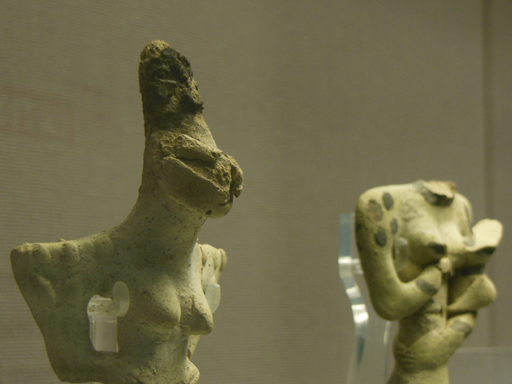
Serpent-headed
clay statues found in Ubaid graves. Are they representations of great ancestors
who possessed elongated heads and long snake-like features? |
The
Coming of the Watchers
Then
we come to the impact Göbekli Tepe had on the earliest Semitic peoples of
North Mesopotamia. Their oral traditions would one day be carried into the land
of Canaan by the first Israelites and recorded down in religious works such as
the book of Enoch and the book of Giants. In these so-called Enochian texts the
prime movers behind the construction of Göbekli Tepe, and the subsequent
Neolithic revolution, are described as human angels called Watchers, who are extremely
tall, wear coats of feathers, possess visages like vipers (that is, extremely
long facial features), and are occasionally described as Serpents (indeed, one
Watcher is named as the Serpent that beguiled Eve in the Garden of Eden). Two
hundred of their number are said to have descended among mortal kind and taken
mortal wives, who produced giant offspring called Nephilim.
According to the
book of Enoch, the human angels revealed to their wives the secret arts of heaven,
many of which correspond with a number of firsts for humanity that took place
in Southwest Asia in the wake of the Neolithic revolution. Are the Watchers a
memory of the appearance in southeast Anatolia of Swiderian groups, whose striking
appearance fits the vivid description of the Watchers offered in Enochian literature?
If so, then does it suggest that the strange appearance of both the Watchers and
the Anunnaki, with their serpent-like faces, might in part be down to them being
Neanderthal-humid hybrids? Were they the true founders of civilization?
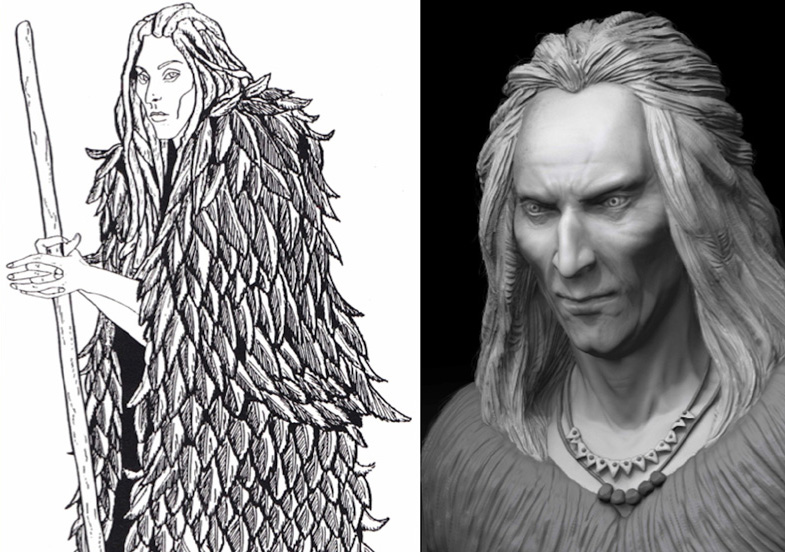
Impression
of a Watcher by artist Billie Walker John in 1995, and Russell M. Hossain's 3D
sculpt based on Billie Walker John's original. |
The
Rivers of Paradise
A
memory also of this crucial epoch in human development is preserved perhaps in
the stories of Adam and Eve in the Garden of Eden. According to the book of Genesis
this was located at the source of the four rivers of Paradise. Three can easily
be identified as the Euphrates, Tigris and Araxes (the biblical Gihon), which
all rise in eastern Anatolia. What is more, two of the rivers, the Euphrates and
Araxes, take their rise in the vicinity of Bingöl Mountain, one of the primary
sources of obsidian located just 200 miles (325 kilometres) from Göbekli
Tepe.
Local
tradition asserts that Bingöl was also the source of the fourth river of
Paradise, the Pison, while ancient writers record that the true source of the
Tigris was in the same region. Armenian tradition also speaks of Bingöl Mountain
being the place of the gods and the summit of the world from which emerge four
great rivers that carry the waters of life to every part of the world. Everything
points toward Bingöl Mountain being not only the "birthplace" of
the Anunnaki, but also the site of the mountain of Paradise, and the place of
descent of the Watchers in the book of Enoch.
The
Secrets of Adam
Gnostic
writings, such as the various tracts found in a cave at Nag Hammadi in Egypt in
1945, speak repeatedly of the so-called secrets of Adam being passed to his son
Seth before his father's death. Seth is said to have recorded them either in book
form, or on tablets or pillars called stelae. These were hidden in or on a holy
mountain, existing in the vicinity of the terrestrial Paradise, so that they might
survive a coming cataclysm of fire and flood (a memory almost certainly of the
Younger Dryas impact event). Called variously Charaxio, Seir, or Sir, this mountain
is linked in early Christian tradition with the site inhabited by the generations
of Adam following the expulsion of the first couple from Paradise.
So
what are the secrets of Adam, and where might they be found today? Do they pertain
to the manner in which Göbekli Tepe was built to curtail the catastrophobia
rife among the indigenous peoples of the region in the wake of the Younger Dryas
impact event? Had this information been given to the local hunter-gatherers of
the region by incoming Swiderian groups, whose elongated heads and long ancestry
was connected with their origins as Neanderthal-human hybrids? Were their deeds
mythologised into the stories of the human angels called Watchers found in the
book of Enoch, and the Anunnaki gods alluded to in Mesopotamian tradition?
As
Angels Ourselves
Where exactly was Charaxio, or Mount Seir, where the books of Seth containing the secrets of Adam await discovery? This is the quest I embark upon in the second half of Göbekli Tepe: Genesis of the Gods, with the result being the discovery in the Eastern Taurus Mountains of a forgotten Armenian monastery overlooking the traditional site of the Garden of Eden. Before its destruction at the time of the Armenian genocide of 1915, the monks here preserved archaic traditions concerning the Garden of Eden and the existence of a holy relic of incredible religious significance. Confirmation of the presence of this holy relic at the monastery (which in the seventh century was given a special decree of immunity from attack signed by the prophet Mohammed himself) reveals what could be Adam's ultimate secret-the manner in which we as mortals can re-enter Paradise and become, as once we were, like angels ourselves. It is a story of discovery I would now like to share with you.
The
Resurrection: The Angels rolling away the Stone from the Sepulchre, Blake, William
(1757-1827) Victoria & Albert Museum, London, UK / The Bridgeman Art Library |
TO
READ A FULL BREAKDOWN OF THE BOOK DOWNLOAD THE ARTICLE
Göbekli
Tepe:
Who Built It, When and Why?
Read
the pre-proof version of the book
Göbekli
Tepe:
Genesis of the Gods
"there
is little question that Andrew was one of the first writers to realize the greater
significance of Göbekli Tepe ... It is for this
reason that Göbekli
Tepe: Genesis of the Gods is such a masterwork, for it is the culmination of
nearly twenty years of Andrew's original research into the origins of the Neolithic
revolution and its relationship to Hebrew traditions concerning the location of
the Garden of Eden and the human truth behind the Watchers of the book of Enoch. "In a testimonial written to accompany the publication of From the Ashes of Angels (1996), I said that Andrew had put important new facts before the public concerning the mysterious origins of human civilization. I stand by this statement and add only that with his vast knowledge of the subject under discussion, there is no one better suited to reveal Göbekli Tepe's place in history today." |
Graham
Hancock from his Introduction
to Göbekli
Tepe: Genesis of the Gods
ARRIVING
MAY 08, 2014 |  |
ABOUT ANDREW COLLINS
Andrew
Collins is a historical
writer and explorer living in the United Kingdom. He is the author of more than
a dozen books that challenge the way we perceive the past. They include From
the Ashes of Angels (1996), which establishes that the Watchers of the book
of Enoch and the Anunnaki of the Sumerian texts are the memory of a shamanic elite
that catalyzed the Neolithic revolution in the Near East at the end of the last
ice age; Gateway to Atlantis (2000), which pins down the source of Plato's
Atlantis to the Caribbean island of Cuba and the Bahaman archipelago; Tutankhamun:
The Exodus Conspiracy (coauthored with Chris Ogilvie Herald, 2002), which
reveals the truth behind the discovery of Tutankhamun's famous tomb; and The
Cygnus Mystery (2007), which shows that the constellation of Cygnus has been
universally venerated as the place of first creation and the entrance to the sky
world since Paleolithic times. In 2008 Andrew and colleague Nigel Skinner Simpson
discovered a previously unrecorded cave complex beneath the pyramids of Giza,
which has brought him worldwide acclaim. It is a story told in his book Beneath
the Pyramids (2009). |
If
you want to experience yourself all the various sites featured in Andrew's new
book Göbekli
Tepe: Genesis of the Gods,
why not join Andrew and Hugh Newman in Turkey in September on a unique tour, the
details of which are given below
GOBEKLI
TEPE
FINDING EDEN TOUR
Monday, Sept 1st - Wednesday, Sept 10th 2014
Explore
Göbekli
Tepe and
Discover the Garden of Eden in Eastern Turkey
Experience ten whole days in some of the most magical, spiritual and beautiful places of eastern Turkey, with Andrew Collins and Hugh Newman in September. Visit Göbekli Tepe - Harran - Nemrut Dag - Çayönü - Sanliurfa: Nimrod's Castle, Pools of Abraham, Archaeological Museum - Diyarbakir Museum - Aktamar Island Church, Lake Van - Gate of Mehr -The Garden of Eden Monastery, Mus - Fountain of Immortality, Mushka - Bingöl Mountain, terrestrial Paradise and birthplace of the Anunnaki and Watchers
(start at Istanbul)
4-DAY OPTIONAL EXTENSION
September 11th - 14th
Visit the ancient Nabataean city of Petra and climb the true Mount Sinai, Jebel Madhbah. See also Ain Musa, the spring of Moses, where the prophet brought forth water after banging the rock, and visit the Wadi Fasasa
![]()

